Chapter-5-Semantics(语义学)
语言学_Chapter 5_Semantics

32
天亮前后,东方地平线上有时会看到一颗 特别 明亮的“晨星”,人们叫它“启明 星”;而在 黄昏时分,西方余辉中有时会 出现一颗非常明 亮的“昏星”,人们叫它 “长庚星”。这两颗 星其实是一颗,即金 星.在中国民间称它为 “太白”或“太白 金星”。古代神话中,“太 白金星”是一 位天神。古希腊人称金星为“阿 佛洛狄 忒”,是代表爱与美的女神。而罗马人 把 这位女神称为“维纳斯”,于是金星也被 称 为维纳斯了
14
M is conventional
15
What is meaning? M is conventional
A green light means ...
16
What is meaning?
Pavlov (巴甫洛夫) Meaning is Stimulus-response
17
M is flexible and imitational
25
4. Problems with the naming theory
1. The theory seems applicable to nouns only. 2. There are nouns which denote things that do not exist in the real world at all. 3. There are nouns that do not refer to physical objects, but abstract notions. 4. Some words may have different meanings in different contexts. 5. The same reference may have different names.
Charpter 5 Semantics 语义学

3.2 major sense relations
Pairs of words can be formed into certain patterns to indicate sense relations. sow/boar, ewe/ram, mare/stallion etc. form a pattern indicating a meaning related to gender.
S
r
s
R
Events before
Speech
Events after speech
speech
EXERCISE TIME 3. The well-known formula: S r…..s R was put forward by____. A. Bloomfield B. Firth C. Hockett D. Harris Answer: A
Comments on the theory: 1) Meanings don’t reside in words, but in people’s minds 2) Individual people have differences in their experiences and personal backgrounds, which affect how people think.
3.2 major sense relations
Duck/duckling, pig/piglet, dog/puppy, lion/cub, etc. form another pattern indicating a relationship between adult and young.
chapter5semantics语言学
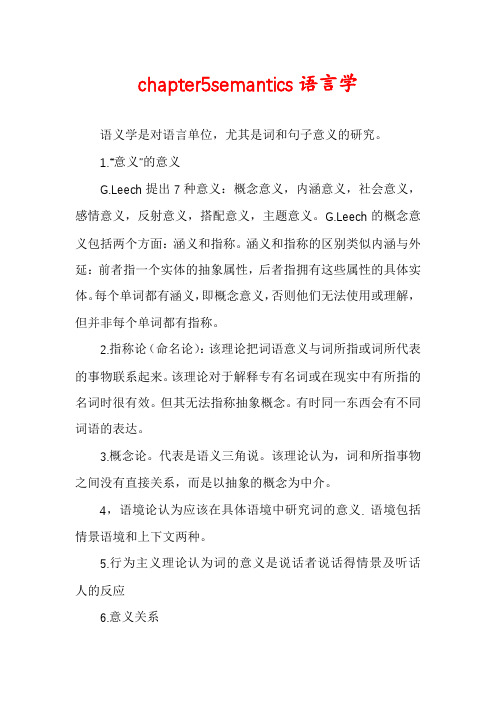
chapter5semantics语言学语义学是对语言单位,尤其是词和句子意义的研究。
1.“意义”的意义G.Leech提出7种意义:概念意义,内涵意义,社会意义,感情意义,反射意义,搭配意义,主题意义。
G.Leech的概念意义包括两个方面:涵义和指称。
涵义和指称的区别类似内涵与外延:前者指一个实体的抽象属性,后者指拥有这些属性的具体实体。
每个单词都有涵义,即概念意义,否则他们无法使用或理解,但并非每个单词都有指称。
2.指称论(命名论):该理论把词语意义与词所指或词所代表的事物联系起来。
该理论对于解释专有名词或在现实中有所指的名词时很有效。
但其无法指称抽象概念。
有时同一东西会有不同词语的表达。
3.概念论。
代表是语义三角说。
该理论认为,词和所指事物之间没有直接关系,而是以抽象的概念为中介。
4,语境论认为应该在具体语境中研究词的意义. 语境包括情景语境和上下文两种。
5.行为主义理论认为词的意义是说话者说话得情景及听话人的反应6.意义关系词语词之间的主要意义关系:相同关系,相反关系,包含关系a.同义关系。
完全同义关系很少,所谓的同一都依赖语境,并总在某方面不同。
(方言,内涵,文体等)b.反义关系主要包括:等级反义关系,互补反义关系,关系反义关系。
1)等级反义的特点:第一,否定一方并不必然是肯定另一方,还有中间状态;第二,没有绝对评判标准,标准随对象而改变。
第三,通常用其中表示较高程度的词来覆盖整个量级。
覆盖性词被称为“无标记的”,即一般性的;被覆盖词被称为“有标记的”,即特殊的。
一般使用覆盖性词语。
一旦使用被覆盖词语,表示有某种特殊的、不一般的情况。
第四,可用very修饰,可有比较级最高级2)互补反义关系,第一,肯定一方意味着否定另一方。
反之亦然。
第二,不用very修饰,没有比较级最高级。
第三,评判标准绝对。
没有覆盖性词语3)关系(反向)反义关系,表现两个实体间的一种反向关系,不构成肯否定对立。
一个预设着另一个的存在。
语言学整理的资料Chapter 5 semantics

Chapter 51.Semantics:自测: __________ can be defined as the study of meaning.术语:Semantics 语义学解释:语义学可以简单的定义为对意义的研究。
术语:semantics is the study of meaning of linguistics units, words and sentences in particular.语义学是对语言单位尤其是词和句子的意义的研究。
解释:Semantics is defined as the study of meaning. However, it is not the only linguistic discipline that studies meaning. Semantics answers the question “what does this sentence mean”. In other words, it is the analysis of conventional meanings in words and sentences out of context. 语义学被定义为对意义的研究,然而,却不仅仅是对语言的意义研究。
语义学回答了“这句话有什么意义”这样的问题。
换句话说,它研究语境外词语和句子的传统意义。
2.Sense:自测:Which of the following is NOT true?A. Sense is concerned with the inherent meaning of the linguistic form.B. Sense is the collection of all the features of the linguistic form.C. Sense is abstract and decontextualized.D. Sense is the aspect of meaning dictionary compilers are not interested in.术语:Sense 涵义解释:涵义指一个实体的抽象属性。
Chapter5Semantics

Chapter5SemanticsChapter 5 Semantics5.1 Definition of SemanticsSemantics is the study of meaning in language.Meaning has been studied for thousands of years by philosophers, logicians and linguists. E.g. Plato & Aristotle.Scholars with different scientific backgrounds have different understandings of language meaning.Philosophers concentrate on the relation between linguistic expressions and things, persons and events in the world to which these expressions refer.Linguists aiming to study the way in which meaning in a language is structured; different types of meaning.C. K. Ogden & I. A. Richards (1923). The Meaning of Meaning.5.2 Approaches to Meaning5.2.1 Meaning as namingproposed by the ancient Greek scholar Plato.The meaning of an expression is what it refers to, or names, is often called referential theory or naming theory.Words are names or labels for things.5.2.2 Meaning as ConceptThe conceptualist view holds that there is no direct link between a linguistic form and what it refers to (i.e. between language and the real world); rather, in the interpretation of meaning, forms and real things are linked through the mediation of concepts in the mind.The symbol or word signifies an object by the concept associated with the form of the word in the minds of the speaker;and the concept viewed in this way is the meaning of the word.5.2.3 Meaning as behaviorBehaviorists attempted to define meaning as “the situation in which the speaker utters it and the response it calls forth in the hearer”.the story of Jack and JillS r--------s RMeaning consists in the relationship between speech indicated by the small letters r……s and the practical events represented by the capitalized letters S and R that precede and follow them respectively.5.2.4 Meaning as context The contextualismMeaning should be studied in terms of situation, use, context—elements closely linked with language behavior. (J. R. Firth)Two types of contexts are recognized:Situational context: spatio-temporal situationLinguistic context: the probability of a word’s co-occurrence or collocation. Linguistic context, some times known as co-text, is concerned with the probability ofa word’s co-occurrence or collocation with another word, which forms part of the “meaning”of the word, and also the part of text that precedes and follows a particular utterance.Situational context refers to the particular spatiotemporal situation in which an utterance occurs, including a the place and time of the speaking, the speaker and the hearer, the actions they are performing at the time, the various objects and events existent in the situation.5.3 Word Meaning5.3.1 Sense and referenceSense is concerned with the inherent meaning of the linguistic form. It is the collection of all the features of the linguistic form; it is abstract and de-contextualized. It is the way people relate words to each other within the framework of their language.Reference deals with the relationship between the linguistic element and the non-linguistic world of experience. What a linguistic form refers to in the real, physical world.(词与外部事物之间的关系)Linguistic forms having the same sense may have different references in different situations; on the other hand, linguistic forms with the same reference might differ in sense, e.g. the morning star and the evening star, black tea and black hair.5.3.2 Seven types of meaningLeech (1974:23) recognizes 7 types of meaning in his book Semantics: The Study of Meaning.e.g.He is a real man.human, adult, male: conceptual meaning (meaning in the dictionary)1. Conceptual meaning(logic, cognitive, denotative)2. Connotative(内涵) meaning3. Social(社会) meaning4. Affective(情感) meaning5. Reflected(反映) meaning6. Collocative(搭配) meaning7. Thematic meaning (order and emphasis)5.3.3 Semantic fieldsa set of words with an identifiable semantic connection. (lexical field)e.g. vegetable: tomato, onion, cucumber, eggplant…fruit: ___ ___ ___ ___ ___color: ___ ___ ___ ___ ___The meaning of a word is decided not by the word itself, but by relationships with other words in the same semantic field.5.3.4 Componential analysis (CA)Componential analysis---- a way to analyze lexical meaning.The approach is based on the belief that the meaning of a word can be dismantledinto meaning components, called semantic features (语义特征).For example,Man: [+HUMAN, +ADULT, +ANIMATE, +MALE]Boy: [+HUMAN, -ADULT,+ANIMATE, +MALE]Woman: [+HUMAN, +ADULT, +ANIMATE, -MALE]Girl: [+HUMAN, -ADULT, +ANIMATE, -MALE]The attraction of CA is that it allows a highly explicit and economical account of meaning relations such as hyponymy and incompatibility.5.3.5 Semantic relationships between words1. Homonymy (同形异义)(good for humor):bank/lie: homonyms2. Polysemy (多义):point3. Homophony (同音异义):know/no (homophones)homography (同形异音异义): sow, wind4. Synonymy (近义):big/large5. Antonymy (反义):good/bad (gradable), boy/girl (complementary),sell/buy (converse)6. Hyponymy (上下义):vegetable/potato7. Meronymy (部分义/整体部分义):car/wheel4. SynonymyIt is the technical name for the sameness relation. English is said to be rich in synonyms.1> They may differ in style.2.> They may differ in connotations.3> They may differ in dialect.5. AntonymyAntonymy is the name for oppisiteness relation. There are three subtypes: gradable antonymy, complementary antonymy, and converse antonymy.1>Gradable AntonymyGradable antonymy is the commonest type of antonymy.They have three characteristic.First, they are gradable. That is, the denial of one is not necessarily the assertion of the other. There is something in between.Secondly, there is no absolute criterion. They are graded against different norms. Thirdly, one member of a pair, usually the term for the higher degree, serves as the cover term.2> Complementary Antonymy(互补反义关系)It also has three characteristics.1 it divides up the whole semantic field. That is to say, the assertion of one means the denial of the other, and the denial of one means the assertion of the other. There is no intermediate ground between them.Secondly, the norm of this type is absolute. It doesn’t vary with the thing a word isapplied to.Thirdly, there is no cover term for the two members of a pair.3> Converse Antonymy(反向反义关系)Converse antonymy is known as relational opposites. This is a special type of antonymy in that the members of a pair do not constitute a positive-negative opposition. They show the reversal of a relationship between two entities. There are always two sides of the same relationship. One presupposes the other.For example, buy/sell, precede/ follow, husband/wife.buy/sell-----X buys something from Y.= Y sells something to X.precede/follow-----Jack precedes Bill.= Bill follows Jack.husband/wife-----Mike is Mary’s h usband.= Mary is Mike’s wife.Note: It is the same relationship seen from two different angles.6. Hyponymy(上下义关系)Hyponymy is meaning inclusiveness or a matter of class membership. The upper term in this sense relation is called superordinate; the lower terms, the members are called hyponyms.A superordinate has several hyponyms. The members of the same class are co-hyponyms.Both superordinates and hyponyms have the same word class.Notes:1> Sometimes a superordinate may be a superordinate to itself or a hyponym of itself, and may be called autohyponym(自我下义词).2> Superordinates or hyponyms may also be missing.In English, there is no superordinate for the color term red, green, yellow, blue, white, black, etc. The term color is a noun, and doesn’t belong to the same word class of its members.In English, there is only one word “uncle”to express “伯伯,叔叔,舅舅,姑父,姨夫.5.4.Sentence Meaning5.4.1 Sentence and Propositionsentence is “something that expresses a complete thought”.Sentences are more knowable than thoughts. In spite of individual differences, speakers of a language generally agree on what is or is not a sentence in their language.They have the same semantic content but different grammaticality. The semantic content shared by the three expressions (1a, b, c) is a proposition which may be judged by truth conditions. A proposition can be expressed in different sentences:(2) a. John broke the glass.b. The glass was broken by John.c. It was John who broke the glass.形式为简单陈述句的一个陈述,其主要内容构成一个意义单位。
新编简明英语语言学教程05Chapter-5-semantics
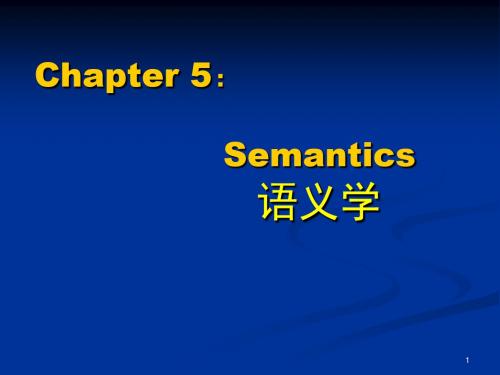
16
Note:
Linguistic forms having the same sense may have different references in different situations; on the other hand, there are also occasions, when linguistic forms with the same reference might differ in sense, e.g. the morning star and the evening star,
用符号或单词表示物体是通过言语者思 维中单词的形式与概念联系起来实现的。 从这个观点看,概念就是单词的意义。
9
Contextualism (语境论)
Meaning should be studied in terms of situation, use, context — elements closely linked with language behavior.
3
Naming theory (Plato)命名论
Words are names or labels for things.
词语只是代表物体的名字或标记。
Limitations:
1) Applicable to nouns only.
2) There are nouns which denote things that do not exist in the real world, e.g. ghost, dragon, unicorn, phenix…
chapter 5 Semantics
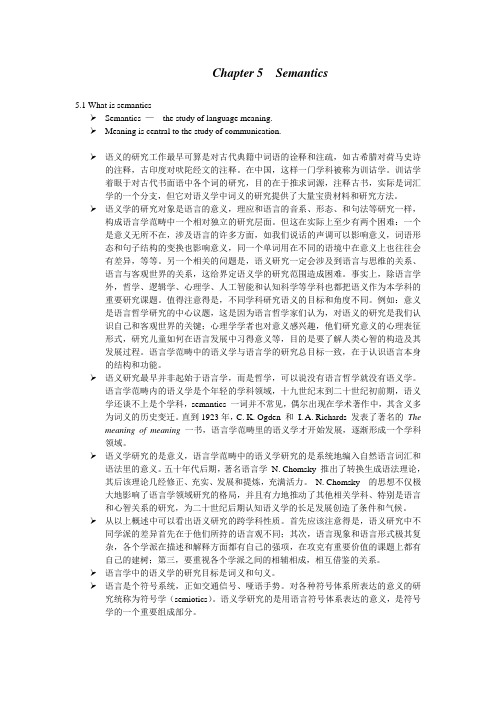
Chapter 5 Semantics5.1 What is semanticsSemantics —the study of language meaning.Meaning is central to the study of communication.语义的研究工作最早可算是对古代典籍中词语的诠释和注疏,如古希腊对荷马史诗的注释,古印度对吠陀经文的注释。
在中国,这样一门学科被称为训诂学。
训诂学着眼于对古代书面语中各个词的研究,目的在于推求词源,注释古书,实际是词汇学的一个分支,但它对语义学中词义的研究提供了大量宝贵材料和研究方法。
语义学的研究对象是语言的意义,理应和语言的音系、形态、和句法等研究一样,构成语言学范畴中一个相对独立的研究层面。
但这在实际上至少有两个困难:一个是意义无所不在,涉及语言的许多方面,如我们说话的声调可以影响意义,词语形态和句子结构的变换也影响意义,同一个单词用在不同的语境中在意义上也往往会有差异,等等。
另一个相关的问题是,语义研究一定会涉及到语言与思维的关系、语言与客观世界的关系,这给界定语义学的研究范围造成困难。
事实上,除语言学外,哲学、逻辑学、心理学、人工智能和认知科学等学科也都把语义作为本学科的重要研究课题。
值得注意得是,不同学科研究语义的目标和角度不同。
例如:意义是语言哲学研究的中心议题,这是因为语言哲学家们认为,对语义的研究是我们认识自己和客观世界的关键;心理学学者也对意义感兴趣,他们研究意义的心理表征形式,研究儿童如何在语言发展中习得意义等,目的是要了解人类心智的构造及其发展过程。
语言学范畴中的语义学与语言学的研究总目标一致,在于认识语言本身的结构和功能。
语义研究最早并非起始于语言学,而是哲学,可以说没有语言哲学就没有语义学。
语言学范畴内的语义学是个年轻的学科领域,十九世纪末到二十世纪初前期,语义学还谈不上是个学科,semantics 一词并不常见,偶尔出现在学术著作中,其含义多为词义的历史变迁。
语言学第五章5_semantics
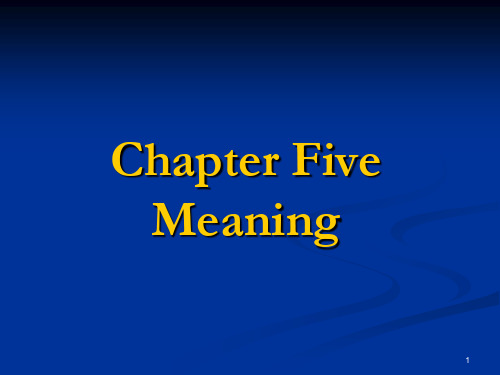
Formal <------------------------------> Informal
23
(4) Affective meaning
Reflecting the personal feelings of the speaker, including his attitude to the listener, or his attitude to something he is talking about.
20
Some words may have the same conceptual meaning, but have different social meaning and stylistic meaning.
21
domicile: very formal, official residence: formal abode: poetic home: general
Pragmatics:
5.semantics

the famous account of Jack and Jill (P65)
Jill
S
r
Jack
s
R
Events before speech
Events after speech
Speech
Jack passes the
“I am thirsty, Jack.” apple to Jill.
coach garage car park lay-by
tube call box telephonist
vest pavement
American English
bus service station
parking lot rest area subway telephone booth operator undershirt sidewalk
a physical stimulus
Types of word meaning
grammatical meaning lexical meaning conceptual meaning associative meaning
connotative stylistic affective collocative meaning meaning meaning meaning
5.1 What is semantics?
Semantics is generally
considered to be the study WWhhaattiisssmemeaannitnicgs??
of meaning in language.
Scholars under different scientific backgrounds have different understandings of language meaning.
语言学Chapter_5_semantics..
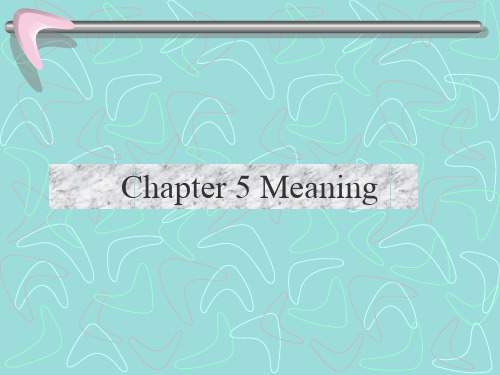
According to this theory, there is no direct link between symbol and referent (between language and the world). The link is via thought or reference, the concepts of our minds.
3. Contextualism
During the period roughly from 1930 to 1960, linguists gave pre-eminence to the empirical or observational aspect in the study of meaning.
Context
Linguistic
Context: the Probability of a Word’s Co-occurrence or Collocation With Another Word.
a piece of paper a daily paper
an examination paper
Some scholars have suggested that
the link is simply a psychological one
---when we think of a name, we think
Chapter 5 Semantics 语义学 语言学教程 胡壮麟
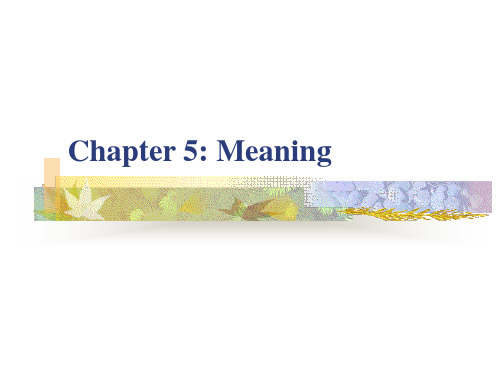
Definitions of Semantics
Semantics can be simply defined as the study of meaning. (Dai & He, 2002, p. 67) Term coined by Bré (1897) for the al subdiscipline of linguistics concerned with the analysis and description of the so-called „literal‟ meaning of linguistic expressions. (Bussmann, 1996, p. 423) Semantics is the study of linguistic meaning: the meaning of words, phrases, and sentences. (Wen, P. 210)
5.1 Meanings of „Meaning‟
Scholars like Ferdinand de Saussure have stressed that the study of linguistic meaning is part of the general study of the use of sign systems, and this general study is called semiotics.
2) It is not possible for some words to find referents in the world, such as the words but, and, of, however, the, etc. 3) Speakers of English understand the meaning of a round triangle although there is no such graph.
chapter-5-semantics语义学

R: non-linguistic RESPONSE of getting the apple
1.5 Meaning as context (p.107)
Contextualist view (inspired by Malinovsky, proposed by Firth): Context determines the meaning; meaning is found in the context within which a particular expression is uttered suggests that we can derive meaning from the observable context.
Reference or extension deals with the relationship between the linguistic elements (words, sentences, etc.) and the nonlinguistic world of experience (things, actions, events and qualities).
1.2 Meaning as naming (p.105)
Naming theory (Plato): the meaning of expression is what it refers to, or names.
The semantic relationship holding between a word and the thing it denotes is the relationship of naming.
chapter 5 Semantics英语专业语言学

linguistic elements & the nonlinguistic world of experience. • E.g.: The dog is barking.
Sense & reference (add)
Leech’s “Seven Meanings” 111-
• 1.Conceptual meaning (denotative meaning/cognitive meaning, central meaning, core meaning)概念义--词的 核心意义.
• 2. Connotative meaning (above its purely conceptual content.)内涵/附加 义
• Linguistic forms having the same sense may have different references in different situations.
• Linguistic forms with the same reference might differ in sense.
Approaches to meaning 104
• 1.The Naming Theory/referential theory—Plato命名说
• Definition: the meaning of an expression is what it refers to, or names.
Problems with naming as meaning
Leech’s “Seven Meanings”112
新编简明英语语言学 Chapter 5 Semantics 语义学

Chapter 5 Semantics 语义学一、定义1. semantics语义学:Semantics can be simply defined as the study of meaning in language.语义学可以简单地定义为对意义的将研究。
二、知识点5.2 Different views of meaning意义研究的不同观点5.2.1 The naming theory命名论(by希腊Scholar Plato)The naming theory命名论:Words are just names or labels for things.词语只不过是其代表的事物的名字或标记。
Eg. desk—a piece of furniture with a flat top and four legs.The limitations of this theory局限性:1. This theory seems applicable to nouns only.这一理论看起来仅适用于名词(Some words are definitelynot lables of object:eg. jump, quickly, pretty, and, in,hearted, think, hard, slowly…)2. There are nouns which denote things that do not exist in the real world:ghost, gragon, unicorn麒麟.有些名词是指世界中根本就不存在的事物。
3. Nouns that do not refer to physical object, but abstract notions such asjoy and impulse.有些名词并不是指实物性的物体,而是指:joy, impulse刺激,这样的抽象概念。
语义学和语用学练习1

Chapter 5 SemanticsI.Decide whether each of the following statements is True or False:1.Dialectal (方言的)synonyms (同义关系)can often be found in different regional dialects suchas British English and American English but cannot be found within the variety itself, for example, within British English or American English. F2.Sense is concerned with the relationship between the linguistic element and the non-linguistic worldof experience, while the reference deals with the inherent meaning of the linguistic form.F3.Linguistic forms having the same sense may have different references in different situations.T4.In semantics, meaning of language is considered as the intrinsic and inherent relation to the physicalworld of experience. F5.Contextualism is based on the presumption that one can derive meaning from or reduce meaning toobservable contexts. T6.Behaviourists attempted to define the meaning of a language form as the situation in which the speakerutters it and the response it calls forth in the hearer. T7.The meaning of a sentence is the sum total of the meanings of all its components. F8.Most languages have sets of lexical items similar in meaning but ranked differently according to theirdegree of formality. T9.“It is iscd:n”-place predication because it contains no argument. T10.In grammatical analysis, the sentence is taken to be the basic unit, but in semantic analysis of asentence, the basic unit is predication, which is the abstraction of the meaning of a sentence. T11.Fill in each of the following blanks with one word which begins with the letter given:11.Semantics can be defined as the study of meaning.12.The conceptualist view holds that there is no direct link between a linguistic form and what it refersto.13.Reference means what a linguistic form refers to in the real, physical world; it deals with therelationship between the linguistic element and the non-linguistic world of experience.14.Words that are close in meaning are called synonyms.15.When two words are identical in sound, but different in spelling and meaning, they are called homophones (同音/形异义词).16.Relational opposites are pairs of words that exhibit the reversal of a relationship between the twoitems.ponential (指数)analysis is based upon the belief that the meaning of a word can bedivided into meaning components.18.Whether a sentence is semantically meaningful is governed by rules called selectional restrictions,which are constraints on what lexical items can go with what others.19.An argument is a logical participant in a predication, largely identical with the nominalelement(s) in a sentence.20.According to the naming theory of meaning, the words in a lan- guage are taken to be labels of theobjects they stand for.III.There are four choices following each statement. Mark the choice that can best completethe statement:21.The naming theory is advanced by A.A.PlatoB.BloomfieldC. Geoffrey LeechD. Firth22.“We shall know a word by the company it keeps.,, This statement represents __B.A.the conceptualist view (概念)B.contexutalismC.the naming theoryD.behaviourism23.Which of the following is not true? DA.Sense is concerned with the inherent meaning of the linguistic form.B.Sense is the collection of all the features of the linguistic form.C.Sense is abstract and decontextualized (去文本化).D.Sense is the aspect of meaning dictionary compilers are not interested in.24.“Can I borrow your bike?”D“You have a bike.”A.is synonymous withB.is inconsistent withC.entailsD.presupposes25. B is a way in which the meaning of a word can be dissected into meaningcomponents, called semantic features.A.Predication analysisponential analysisC.Phonemic analysisD.Grammatical analysis26.“Alive” and “dead” are C.A.gradable antonymsB.relational opposites (关系对立)plementary antonymsD.None of the above27. A deals with the relationship between the linguistic element and the non-linguisticworld of experience.A.ReferenceB.ConceptC.SemanticsD.Sense28. C refers to the phenomenon that words having different meanings have the same form.A.PolysemyB.SynonymyC.HomonymyD.Hyponymy29.Words that are close in meaning are called D.A.homonymsB.polysemyC.hyponymsD.synonyms30.The grammaticality of a sentence is governed by A.A.grammatical rulesB.selectional restrictionsC.semantic rulesD.semantic featuresW. Define the following terms:31.Semantics32.sense33.reference34.synonymy35.polysemy36.homonymy37.homophones38.Homographsplete homonyms40.hyponymy41.antonymy42 componential analysis43.grammatical meaning44.predication45.Argument46.predicate47.two-place predicationV. Answer the following questions:48.Why do we say that a meaning of a sentence is not the sum total of the meanings of all itscomponents?49.What is componential analysis? Illustrate it with examples.50.How do you distinguish between entailment and presupposition in terms of truth values?51.How do you account for such sense relations between sentences as synonymous relation,inconsistent relation in terms of truth values?52.According to the way synonyms differ, how many groups can we classify synonyms into? Illustratethem with examples.53.What are the major views concerning the study of meaning? How they differ?Chapter 6 PragmaticsI. Decide whether each of the following statements is True or False:1.Both semantics and pragmatics study how speakers of a language use sentences to effect successfulcommunication2.Pragmatics treats the meaning of language as something intrinsic and inherent.3.It would be impossible to give an adequate description of meaning if the context of languageuse was left unconsidered.4.What essentially distinguishes semantics and pragmatics is whether in the study of meaning thecontext of use is considered.5.The major difference between a sentence and an utterance is that a sentence is not uttered while anutterance is.6.The meaning of a sentence is abstract, but context-dependent.7.The meaning of an utterance is decontexualized, therefore stable.8.Utterances always take the form of complete sentences9.Speech act theory was originated with the British philosopher John Searle.10.Speech act theory started in the late 50’s of the 20th century.11.Austin made the distinction between a constative and a performative.12.Perlocution ary act is the act of expressing the speaker’s intention.II.Fill in each blank below with one word which begins with the letter given:13.P is the study of how speakers of a language use sentences to effect successfulcommunication.14.What essentially distinguishes s and pragmatics is whether in the study of meaningthe context of use is considered.15.The notion of c is essential to the pragmatic study of language.16.If we think of a sentence as what people actually utter in the course of communication, it becomes anu.17.The meaning of a sentence is a, and decontexualized.18. C were statements that either state or describe, and were thus verifiable.19.P were sentences that did not state a fact or describe a state, and were not verifiable.20. A l act is the act of uttering words, phrases, clauses. It is the act of conveying literalmeaning by means of syntax, lexicon and phonology.21.An i act is the act of expressing the speaker’s intention; it is the act performed insaying something.22. A c is commit the speaker himself to some future course of action.23.An e is to express feelings or attitude towards an existing state.24.There are four maxims under the cooperative principle: the maxim of q, the maxim of quality, themaxim of relation and the maxim of manner.III.There are four choices following each statement. Mark the choice that can best complete the statement:25.does not study meaning in isolation, but in context.A.PragmaticsB.SemanticsC.Sense relationD.Concept26.The meaning of language was considered as something in traditional semantics.A.contextualB.behaviouristicC.intrinsicD.logical27.What essentially distinguishes semantics and pragmatics is whether in the study of meaningis considered.A.referenceB.speech actC.practical usageD.context28. A sentence is a concept, and the meaning of a sentence is often studied in isolation.A.pragmaticB.grammaticalC.mentalD.conceptual29.If we think of a sentence as what people actually utter in the course of communication, it becomesa(n).A.constativeB.directiveC.utteranceD.expressive30.Which of the following is true?A.Utterances usually do not take the form of sentences.B.Some utterances cannot be restored to complete sentences.C.No utterances can take the form of sentences.D.All utterances can be restored to complete sentences.31.Speech act theory did not come into being until.A.in the late 50’s of the 20the centuryB.in the early 1950’sC.in the late 1960’sD.in the early 21st century32.is the act performed by or resulting from saying something; it is the consequence of, or the changebrought about by the utterance.A. A locutionary actB.An illocutionary actC. A perlocutionary actD. A performative act33.According to Searle, the illocutionary point of the representative is.A.to get the hearer to do somethingB.to commit the speaker to something’s being the caseC.to commit the speaker to some future course of actionD.to express the feelings or attitude towards an existing state of affairs34.All the acts that belong to the same category share the same purpose, but they differ .A.in their illocutionary acts.B.in their intentions expressedC.in their strength or forceD.in their effect brought about35.is advanced by Paul GriceA.Cooperative PrincipleB.Politeness PrincipleC.The General Principle of Universal GrammarD.Adjacency Principle36.When any of the maxims under the cooperative principle is flouted,might arise.A.impolitenessB.contradictionsC.mutual understandingD.conversational implicaturesW・ Define the terms below:37.pragmatics38.context39.utterance meaning40.sentence meaning41.constative42.performative43.locutionary act44.illocutionary act45.perlocutionary act 46. Cooperative PrincipleV. Answer the following questions as comprehensively as possible. Give examples fOr illustration if necessary:47.How are semantics and pragmatics different from each other?48.How does a sentence differ from an utterance?49.How does a sentence meaning differ from an utterance meaning?50.Discuss in detail the locutionary act, illocutionary act and perlocutionary act.51.Searle classified illocutionary act into five categories. Discuss each of them in detail withexamples.52.What are the four maxims under the cooperative principle?53.How does the flouting of the maxims give rise to conversational implicatures?。
最新语言学第五章要点资料

Chapter 5 Semantics 语义学1.What is semantics?什么是语义学?Semantics can be simply defined as the study of meaning in language.语义学可定义为对语言意义的研究。
2.Some views concerning the study of meaning语义研究的几种主要理论1)The naming theory 命名论It was proposed by the ancient Greek scholar Plato. According to this theory, the linguistic forms or symbols, in other words, the words used in a language are taken to be labels of the objects they stand for. So words are just names or labels for things.命名论是最原始的语义理论,是古希腊学者柏拉图提出的。
该理论把词看作是该词所指事物的名称或标记。
2)The conceptualist view 意念论The conceptualist view holds that there is no direct link between a linguistic form and what it refers to; rather, in the interpretation of meaning they are linked through the mediation of concepts in the mind.意念论认为,语言形式及其所代表的对象之间(即语言与现实世界之间)没有直接联系;确切地说,在理解语义时,是通过大脑中存在意念这一中介物来联系的。
新编语言学教程名词解释
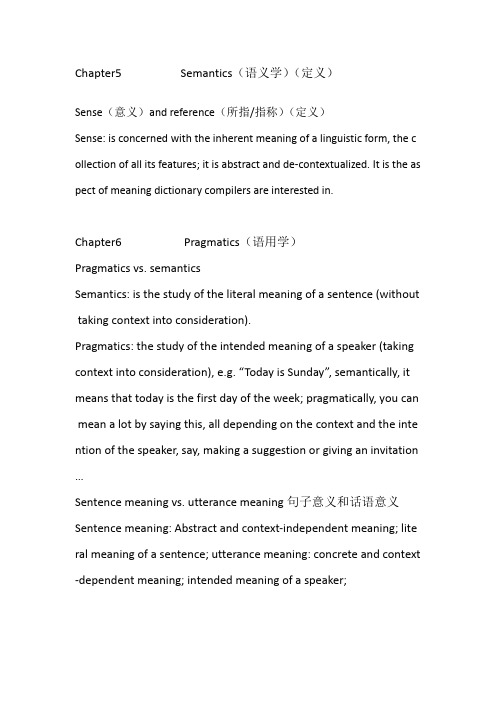
Chapter5 Semantics(语义学)(定义)Sense(意义)and reference(所指/指称)(定义)Sense: is concerned with the inherent meaning of a linguistic form, the c ollection of all its features; it is abstract and de-contextualized. It is the as pect of meaning dictionary compilers are interested in.Chapter6 Pragmatics(语用学)Pragmatics vs. semanticsSemantics: is the study of the literal meaning of a sentence (without taking context into consideration).Pragmatics: the study of the intended meaning of a speaker (taking context into consideration), e.g. “Today is Sunday”, semantically, it means that today is the first day of the week; pragmatically, you can mean a lot by saying this, all depending on the context and the inte ntion of the speaker, say, making a suggestion or giving an invitation …Sentence meaning vs. utterance meaning句子意义和话语意义Sentence meaning: Abstract and context-independent meaning; lite ral meaning of a sentence; utterance meaning: concrete and context -dependent meaning; intended meaning of a speaker;Chapter11Second Language AcquisitionConnections between first language acquisition and second la nguage acquisition:The first language study has served as a backcloth for perceiving and understanding new facts about second language learning (Littlewoo d, 1986).Positive transfer: facilitate target language learningNegative transfer: interfere or hinder target language learningIt is believed that differences between the native language and the t arget language would pose difficulties in second/foreign language le arning and teaching, e.g. *To touch the society .*There are more people come to study in the states.*I wait you at the gate of the schoolErrors & mistakesErrors: unintentionally deviant from the target language and not self -corrigible by the learner (failure in competence);Mistakes: either intentionally or unintentionally deviant forms and s elf-corrigible (failure in performance).。
自考英语语言学Chapter 5 Semantics

Chapter 5 Semantics语义学一、本章纲要二、本章重点1.What is semantics? 什么是语义学A study of meaning in language(2003填空). Linguists cannot agree among themselves as to what meaning is. Philosophers are interested in understanding the relations between linguisticexpressions and the phenomena in the real word they refer to and in evaluating the conditions of truth and falsehood of such expressions. Psychologists focus their interest on understanding the human mind through language.2.Some views concerning the study of meaning2.1 The naming theory命名论(2005单选;2007名词解释)It is one of the oldest notions concerning meaning, and also a very primitive one, proposed by Greek scholar Plato. According to his theory, the linguistic form of symbols, in other words, the words used in a language are taken to be labels of the objects they stand for. So words are just names or labels for things. 命名论是最原始的语义理论,由古希腊学者柏拉图提出。
Chapter 5 Semantics

Approaches to meaning (2)
According to conceptualism, words and objects are related through the mediation of concepts of the mind. Ogden & Richards (1923) were the first to develop what can be called a “referential” theory of meaning illustrated by the classic “semiotic triangle”, which looks upon the relation between words and objects as a triangle:
Generally, semantics is a branch of linguistics, which is concerned with the study of meaning in language. Semantics studies the nature of meaning and why particular linguistic expressions have the meanings they do.
Semantics
What is semantics? Approaches to meaning Sense and reference Word meaning Sentence meaning Ambiguity Semantic analysis
What is semantics?
Approaches to meaning
The definition of meaning has long plagued linguists and philosophers, because “meaning” covers a variety of aspects of language and there is no general agreement about the nature of meaning. Various different interpretations have thus far arisen. In the following discussion, we are going to cover: (1)the naming view (theory), (2)conceptualism, (3)the behaviorist approach, (4)the contextual theory.
- 1、下载文档前请自行甄别文档内容的完整性,平台不提供额外的编辑、内容补充、找答案等附加服务。
- 2、"仅部分预览"的文档,不可在线预览部分如存在完整性等问题,可反馈申请退款(可完整预览的文档不适用该条件!)。
- 3、如文档侵犯您的权益,请联系客服反馈,我们会尽快为您处理(人工客服工作时间:9:00-18:30)。
• Three types of connotative meanings: • positive(褒义), neutral(中性),negative(贬义)
• A good meal, • A good car, • A good movie, • a good road, • A good child, • good weather • A good umbrella
• A fast road, • a fast typist • A fast book • A fast decision.
the hearer (stimulus—response)
Jill is hungry and wants Jack to pick the
apple for her from the tree:
Jill
Jack
• S-------------r…….s---------------R
• 证实论:一个句子只有得到经验证实才有 意义:John is outside。
Chapter 5 Semantics(语义学)
5.1 what is semantics
• Semantics(语义学)is the study of meaning.
• What is meaning? Love, friendship, truth, fact, democracy, good, chair, ghost, unicorn;真善美,justice, soul
hope, democracy 4 sentence , five, I, he
• 2 conceptualist view
• Meaning is the concept or idea in the mind: • “chair”does not refer to a specific chair,
• “we shall know a word by the company it keeps”
• “The meaning of a word is its use in the language” what is the meaning of “five”?
• It is raining: 取消比赛;客人不要走;进屋; • “以前我和你一样;以后你和我一样。”
• A heavy blow • Heavy traffic • A heavy heart(沉重的心情) • A heavy smoker • Heavy applause(热烈的掌声) • Heavy foliage(密叶) • Heavy invester
Synonymy(同义关系)
• Synonymy:two or more words have the same meanings.
• Philosophy • Psychology • Logic • Semiotics • computer science Anthropology
all study meaning
• sub-branches of semantics: in terms of
whether it falls within the scope of linguistics: linguistic semantics(语言语 义学)and non-linguistic semantics(非语 言语义学):philosophical semantics,
• Adj: right, wrong, tall, deep, • Verb:remember, dream, hate, • Conj: or. And, because, to of
• If you do not ask me “what is meaning” , I know the meaning. But if you ask me what is meaning, I do not know the meaning of sth.
• Denotation: the objects or state of affairs in the real world that linguistic expressions stand for.
• Denotation is invariant and utteranceindependent while reference is variable and utterance dependent, could be specific.
• Textual semantics: the meaning of a text or a piece of discourse.
5.2 theories of meaning
• 1 Naming(命名): words are labels for things they stand for.
white smoking gun
4 Behaviorism(行为主义)
• Meaning is the behavior that language
evokes: the situation in which the speaker
utters it and the response it calls forth in
• Context: situational context(情景语 境):speaker, hearer, place and time of the
utterance, the actions they perform.
• Linguistic context or co-text(语言语境,上 下文):black hair, black tea, black coffee (不加牛奶)black humour,black eye(青肿 眼眶。 Cultural context: dragon,dog,
• Conceptual meaning(概念意义): the meaning given in the dictionary:
• Associative meaning(联想意义):the secondary meaning supplemented to the conceptual meaning: connotative, stylistic, affective and collocative meanings(搭配意义). Handsome man, handsome woman, cute girl VS cute man
• Referent: the entity(实体) or objects to which a linguistic expression refers to.
• Some words do not have referent: would, if, ghost
• Sense(意义) refers to the relationship inside language, the set or nework of relationship between an expression and other expressions in a language. Sense is interlexical(词汇之间) and intralingual(语 言内部) while reference is extralingual
• All misers are stingy. • All misers are rich. • All misers are miserable. • All bachelors are unmarried • All bachelors are happy. • All carnivores(食肉动物) eat meat • What about giant panda that bamboo
but to the concept of all the chair in the world.
• Semantic triangle(语义三角论) or semiotic triangle developed by Odgen and Richards: symbol, thought and referent(指称物) or sign,meaning, and object:
the referent, linguistic expressions relates to the real world only through their meaning
3 contextualism
• Meaning should be studies in terms of situation,context, use.
• Grammatical meaning: the part of meaning of a word which indicates grammatical function or relations. Like number, tense.
• Lexical meaning: the meaning that is codified in a lexicon or dictionary. Open class of elements
shoots. Birds VS bats
Basic concepts
• Reference(所指,指称): the relation between the linguistic expression and the object in extra-linguistic reality to which the expression refers to.
